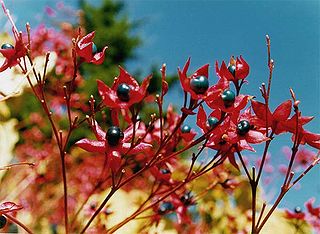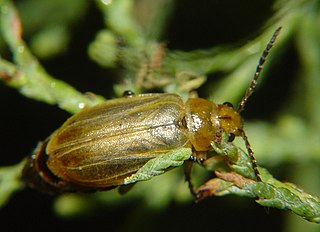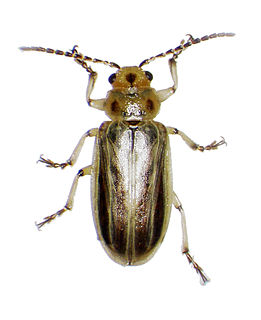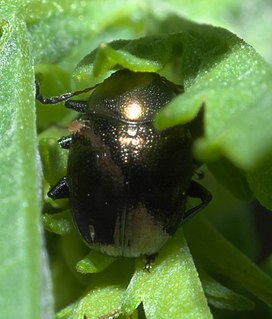Related Research Articles

Biological control or biocontrol is a method of controlling pests such as insects, mites, weeds and plant diseases using other organisms. It relies on predation, parasitism, herbivory, or other natural mechanisms, but typically also involves an active human management role. It can be an important component of integrated pest management (IPM) programs.

Shepherd's beaked whale, also commonly called Tasman's beaked whale or simply the Tasman whale, is a cetacean of the family Ziphiidae. The whale has not been studied extensively. Only four confirmed at sea sightings have been made and 42 strandings recorded. It was first known to science in 1937, being named by W. R. B. Oliver after George Shepherd, curator of the Wanganui Museum, who collected the type specimen near Ohawe on the south Taranaki coast of New Zealand's North Island, in 1933.

Aphthona is a genus of beetle, in the leaf beetle family Chrysomelidae, native to Europe and Asia. More specifically, Aphthona are flea beetles, meaning they have enlarged hind legs for jumping away from potential danger. There are 135 species known from the Palaearctic region.

Alangium is a small genus of flowering plants. The genus is included either in a broad view of the dogwood family Cornaceae, or as the sole member of its own family Alangiaceae. Alangium has about 40 species, but some of the species boundaries are not entirely clear. The type species for Alangium is Alangium decapetalum, which is now treated as a subspecies of Alangium salviifolium. All of the species are shrubs or small trees, except the liana Alangium kwangsiense. A. chinense, A. platanifolium, and A. salviifolium are known in cultivation.

Clerodendrum is a genus of flowering plants in the family Verbenaceae. Its common names include glorybower, bagflower and bleeding-heart. It is currently classified in the subfamily Ajugoideae, being one of several genera transferred from Verbenaceae to Lamiaceae in the 1990s, based on phylogenetic analysis of morphological and molecular data.

Lantana camara is a species of flowering plant within the verbena family (Verbenaceae), native to the American tropics. Other common names of L. camara include big-sage (Malaysia), wild-sage, red-sage, white-sage (Caribbean), korsu wiri or korsoe wiwiri (Suriname), tickberry, West Indian lantana,, umbelanterna and Gu Phool in Assam, India.

Clerodendrum quadriloculare is a species of flowering plant native to New Guinea and the Philippines. It is one of many species previously included in the family Verbenaceae, but transferred to the Lamiaceae based on molecular studies. The plants produce flowers which look good in a garden, but it can be difficult to eradicate.

Diorhabda carinulata is a species of leaf beetle known as the northern tamarisk beetle, which feeds on tamarisk trees from southern Russia and Iran to Mongolia and western China. This beetle is used in North America as a biological pest control agent against saltcedar or tamarisk, an invasive species in arid and semiarid ecosystems.

Diorhabda elongata is a species of leaf beetle known as the Mediterranean tamarisk beetle (MTB) which feeds on tamarisk trees from Portugal and Algeria east to southern Russia. The MTB is used in North America as a biological pest control agent against saltcedar or tamarisk, an invasive species in arid and semi-arid ecosystems.

Diorhabda carinata is a species of leaf beetle known as the larger tamarisk beetle which feeds on tamarisk trees from Ukraine, eastern Turkey and Syria east to northwest China, Kyrgyzstan and Pakistan, extending as far south as southern Iran. It is used in North America as a biological pest control agent against saltcedar or tamarisk, an invasive species in arid and semi-arid ecosystems.

Diorhabda sublineata is a leaf beetle known as the subtropical tamarisk beetle (STB). The species was first described by Hippolyte Lucas in 1849. It feeds on tamarisk trees from Portugal, Spain and France to Morocco, Senegal, Algeria, Tunisia, Egypt, Yemen, and Iraq. It is used in North America as a biological pest control agent against saltcedar or tamarisk, an invasive species in arid and semi-arid ecosystems.

Diorhabda meridionalis is a species of leaf beetle known as the southern tamarisk beetle (SoTB) which feeds on tamarisk trees from Syria to western and southern Iran and southern Pakistan. The SoTB may have potential for use in North America as a biological pest control agent against saltcedar or tamarisk, an invasive species in arid and semi-arid ecosystems.

Ligustrum robustum grows as a shrub or small tree up to 10 m (30 ft) tall though old specimens of more than a hundred years have been observed with a height of 15 m (50 ft). The fruit of the shrub is an ellipsoid berry, bluish-purple when fully ripe, 7–10 mm (0.28–0.39 in) × 4–5 mm (0.16–0.20 in).

The honeycomb whipray is a species of stingray in the family Dasyatidae, found widely in the shallow coastal waters of the Indo-Pacific from India to the Malay Archipelago. This large species grows to 1.3 m (4.3 ft) across and has a diamond-shaped disc with rounded corners and a projecting, pointed snout. Its tail is long and whip-like, without fin folds. Adults have a striking dorsal color pattern consisting of large, dark brown rings and reticulations delineated by thin yellow lines, while juveniles have a pattern of large dark spots. This ray can also be distinguished from its similar relatives by an enlarged, pearl-like dermal denticle at the center of the back, which is followed by a few thorns. The International Union for Conservation of Nature (IUCN) has assessed the honeycomb whipray as Vulnerable, as it faces heavy fishing pressure and habitat degradation across much of its range.

Zygogramma suturalis, commonly known as the ragweed leaf beetle, is a species of leaf beetle belonging to the genus Zygogramma. Native to North America, it has been introduced into Russia and China for the biological pest control of ragweed.

Rhembastus is a genus of leaf beetles in the subfamily Eumolpinae, native to Africa. Whilst the taxonomy of the genus is disputed, the genus has been suggested as a biological control agent for Bryophyllum delagoense in Australia.

Phyllotreta undulata, known generally as the small striped flea beetle or turnip flea beetle, is a species of flea beetle in the family Chrysomelidae. It is found in Australia, Europe & Northern Asia, North America, and Oceania.

Eumolpini is a tribe of leaf beetles in the subfamily Eumolpinae. It is the largest tribe in the subfamily, with approximately 170 genera found worldwide. Members of the tribe almost always have a longitudinal median groove on the pygidium, which possibly helps to keep the elytra locked at rest. They also generally have a subglabrous body, as well as appendiculate pretarsal claws.

Typophorini is a tribe of leaf beetles in the subfamily Eumolpinae. The tribe contains approximately 100 genera, which are found worldwide. Members of the tribe are mainly characterized by antenna cleaners on the tibiae of the middle and hind legs. They also generally have a subglabrous body, as well as bifid pretarsal claws.
References
- 1 2 3 Mohamad S. Mohamedsaid (2009). "Chrysomelidae of the Lesser Sunda Islands: Wallace's Line and the crossing of worlds". In Pierre Jolivet; Jorge Santiago-Blay; Michael Schmitt (eds.). Research of Chrysomelidae, Volume 2. Brill. pp. 57–104. ISBN 978-90-04-16947-0.
- 1 2 D. F. Waterhouse (1993). "Clerodendrum chinense (Osbeck) Mabberley (formerly C. philippinum). Honolulu rose". Biological Control: Pacific Prospects - Supplement 2 (PDF). Australian Centre for International Agricultural Research. pp. 73–94. ISBN 1-86320-076-2.
- ↑ S. J. van Ooststroom (1947). "Over de variabiliteit van Phyllocharis undulata (L.) (Col., Chrysom.)" [On the variability of Phyllocharis undulata (L.) (Col., Chrysom.)]. Tijdschrift voor Entomologie (in Dutch). 88: 543–546.
| This Chrysomelinae article is a stub. You can help Wikipedia by expanding it. |